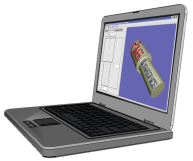A new online ultrasonics components store has just opened at www.UltrasonicsWorld.com. Check their amazing prices for replacement ultrasonics components, fully compatible with the major manufacturers' originals at a fraction of the cost.
You are here
Ultrasonic metal-forming
Back in the 1970's, ultrasonic tube- and wire-drawing was a popular research subject, and some equipment was put into production. More recently these heavy-industrial applications seem to have dropped out of sight. Can anyone tell me of equipment still in use today?
My own experience of power ultrasonics is mainly in this field. CarnaudMetalbox R&D (now a part of Crown Cork and Seal - the biggest packaging company in the world) and Loughborough University developed a new aerosol can using a number of novel metal-forming processes, starting with ultrasonic necking (i.e. reducing the diameter of the can at one end). The advantage of using ultrasonics in this case was to minimise friction between the can and the die, thus reducing the forming force. Without ultrasonics the force was so high that the can body would buckle and collapse during the necking process. With ultrasonics a 30% reduction in can diameter could be achieved in a single operation (in conventional necking processes the maximum is typically about 5%).
The ultrasonics were only effective when the vibrations were perpendicular to the surface - for a cylindrical can this meant developing a round die that would vibrate in the radial direction. As with other high-power applications, all tooling had to be resonant, so the desired mode of resonance was a uniform hoop expansion / contraction. We quickly found that while it was fairly easy to design a die to resonate in this mode at the frequency of the ultrasonic equipment, excluding other modes of vibration was a major challenge!
Another difficulty was that with the whole die expanding and contracting there was no convenient nodal (stationary) point which could be used for mouning it. This was solved by the use of a tubular mounting system which was itself resonant at the same frequency as the die.
The ultrasonic forming process went into production making small-diameter aerosol cans in a UK factory. The production line still runs intermittently, making promotional packaging for several prominent customers. One of its products ("Fleurs de Paris" parfum deospray can) won a silver in the 1997 Metal Packaging Manufacturers Association awards.


Comments
I think it was discovery
I think it was discovery channel or history that had a special and were talking about all types of metallurgy and welding. They were at oklahoma city welding showing the different types.
A relative new technology
A relative new technology that I work with it the roll forming using press brakes. The concept is not new but the technology is new and we've reach a high level efficiency compared with a low cost. I think that something that deserve some attention in mechanical engineering.